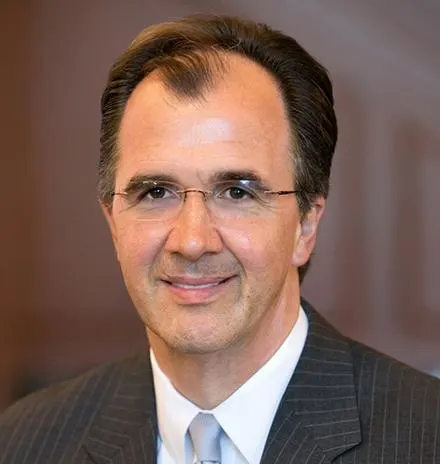
Harvard Business School Professor Stefan Thomke describes how his Executive Education students use LEGO blocks to design customer experiences.
Harvard Business School Professor Stefan Thomke describes how his Executive Education students use LEGO blocks to design customer experiences. (Video by Executive Education)
Why do some product or service experiences have enough pizzazz to wow customers, while others are shrugged off as ho-hum and quickly forgotten?
Stefan Thomke, the William Barclay Harding Professor of Business Administration at Harvard Business School, explains that “the difference has less to do with catchy marketing and everything to do with the design of the experience itself.”
Consider GE Heathcare’s Doug Dietz, who didn’t realize that children saw the company’s MRI scanners as cold, scary chambers of misery until he visited a hospital and saw for himself. The machines created enough fear and tears that many kids needed to be sedated.
The scanners were functional enough, but their design failed to take into consideration the intense emotions of parents and children. So Dietz and his team embarked on a patient-centered redesign by attempting to view the diagnostic procedure through the eyes of a child.
The result: Adventure Series scanners that make children feel like they’re on a theme park adventure. The newly configured machines transformed children from distraught to happy, leading to a pleasant ripple effect: collective relief among parents, a sharp reduction in sedations, and satisfaction scores that jumped by 90 percent. “Dietz’s team turned an experience that was horrible into a wonderful experience,” says Thomke.
He included GE Healthcare as an example of a company making a customer experience turnaround in a recently released learning exercise Designing Transformational Customer Experiences. The exercise helps companies discover design principles that make experiences great. (The accompanying teaching note is available to instructors to help them run the exercise.)
Thomke, who has worked with global firms on upping their customer experience game, has taught the class in the HBS executive education programs, MBA program, at HBS reunions, conferences, and in company workshops. He will be running the session in the Leading Product Innovation executive education program on the HBS campus in February.
Creating a memorable experience
When it comes to providing the type of experience we gush about to friends, many companies are falling down on the job. A survey found that 65 percent of customers are likely to speak negatively about their experience, and 48 percent who had negative experiences shared them with 10 or more other people, according to a study in a 2010 Harvard Business Review article. Only 25 percent were likely to say positive things, and only 23 percent with positive experiences told 10 or more others.
Experience designers are told to follow standard operating procedures and provide customers with programmed responses
Sure, some customer experiences are just plain awful—like GE’s scanner-monsters before they were reimagined. Others suffer from being ordinary, mediocre, and forgettable. That’s because many organizations tackle customer experience by relying on haphazard efforts, Thomke says, like brainstorming, trial and error, and market research through focus groups.
In doing so, they often look to avoid terrible encounters at all costs, with a focus on creating consistency and weeding out variability. Experience designers are told to follow standard operating procedures and provide customers with programmed responses.
This approach may lead to fewer complaints overall, but still, it’s a lost opportunity.
“When a negative experience gets management’s attention, they immediately get nervous and move in and want to shut everything down by tightening controls, focusing on process, and taking autonomy away from their people,” Thomke says. “Because they’re worried about the negative experience, they make sure customers get what they expect. But when you get exactly what you expect at a restaurant, you won’t remember a week later that you were at that restaurant.”
In contrast, exceptionally great experiences stand out, create memories for years, increase loyalty, and lead to a massive multiplier effect when one customer shares the details with others in today’s super-connected consumer world. “We forget that the things that really stick, the things people talk about years later, are not the average experiences, but the outliers on the other end of the spectrum,” Thomke says.
In his teaching, Thomke asks business executives to think of a great customer experience they’ve had, as well as a terrible one. What’s particularly novel about Thomke’s approach is that students learn through a methodology called LEGO Serious Play, and storytelling. (LEGO Serious Play, or LSP, has been used by many global companies, including Google, Microsoft, and Fedex, to foster creativity, deepen learning, and solve complex problems.)
Thomke became a certified LSP facilitator and then spent more than a year working on the design of his class, with the intent of creating a student learning experience to match the theme of the discussion. As part of that experience, executives use LEGO bricks to build models that reflect their positive and negative experiences.
“It’s not about building objects. It’s about solving problems,” explains Thomke, who has co-authored a case about LEGO. “We have five senses, but we usually rely on sight and sound when we sit in meetings, and we don’t use our other senses. When you use the hand-mind connection, you’re using touch, and you start thinking with your hands and you draw things out of your subconscious.”
When students share their own experiences, few of the stories, if any, tend to be about meeting customer expectations, providing value, or generating good functionality. Instead, they are more often about encountering an unexpected problem: A consumer heads to an Apple store with a broken iPhone. An airline customer arrives at the airport without a driver’s license.
They begin to worry they are doomed to an awful encounter, yet they are surprised when an employee far exceeds their expectations by going the extra mile in helping them out—sometimes by going against an organization’s standard procedure.
“People think the world is going to come down on them. It turns out that this is the greatest opportunity for a company to move in and create a memorable experience,” Thomke says. “A problem could be a problem, or a problem could be an opportunity.”
A problem could be a problem, or a problem could be an opportunity
When teaching the subject, Thomke’s students end up discovering design principles that can act as building blocks to a great product or service experience. The teaching note outlines three examples, using real stories from students to illustrate each one:
Solve problems with empathy and exceed expectations. “Our family went to Disneyworld and I lost my purse. Tickets, money, and IDs were all gone. A Disney employee gave me food vouchers for the family, park tickets for the following days, and helped with any inconveniences that we faced. While we enjoyed the rest of the day in the park, they looked for my purse and eventually found it.”
Become your customer’s champion and own the problem. “We landed after a delayed 12-hour flight and learned that our connecting flight was gone. Our expectations were low because we flew on a mileage ticket from American Express. The airline agent ignored us. So we called Amex and the agent took care of everything (rebooking flights, notifying the airline, checking on our luggage). Forty-five minutes later, we were boarding the next flight.”
Trust your customers, take immediate action, and do not blame them. “After a long trip to India, my tired family arrived at a Taj Hotel in the middle of the night, but the front desk couldn’t find our reservation. The night manager immediately took us to our rooms so we could rest and even gave us an upgrade for the inconvenience. (We waited less than five minutes.) He didn’t ask for a credit card or any other kind of information. When we woke up, the problem was solved and it wasn’t even the hotel’s fault. Our booking agent had made a mistake.”
The good deed that keeps on giving
“Does it make economic sense to go over the top with it?” Thomke asks. “I would say ‘yes’ because it creates that stickiness which is hard to measure. Aside from that customer coming back, you are going to benefit from word of mouth. I’ve had students telling stories about things that happened more than 10 years ago.”
Rather than worrying only about offering customers a discount on products or services or focusing on how fast employees can process transactions, companies could benefit in the long run from empowering their employees to meet customers’ emotional needs more often.
For example, an equipment company gave its frontline employees a “memorable experience budget” to solve customer problems without needing higher approval. An Indian hotel chain allowed employees to spend money on creating “moments of delight” for customers—and in 2013, staff logged more than 30,000 such moments for the chain’s hotel guests. Apple store employees are trained to handle upset customers; when a customer has a problem, workers are instructed to take their time to understand the issue, show empathy, and solve it.
“I’m not saying functionality and value aren’t important, but you should aim for the hearts of your customers, not just their heads,” Thomke says. “You do that through empathy, by putting yourself in the customer’s shoes. You take over. You say, ‘Let me take care of everything.’ But you can do these things only if your organization encourages you to do that.”

